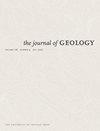超越锆石:将碎屑长石Pb同位素分析纳入沉积物源分析的多代理工具箱-以长期存在的东劳伦碎屑体系为例
IF 1.3
4区 地球科学
Q2 GEOLOGY
引用次数: 2
摘要
碎屑钾长石的常见Pb同位素组成(207Pb/204Pb与206Pb/204Pc)是在劳伦斯东南部的同一碎屑单元上测量的,这些碎屑单元以前以碎屑锆石和碎屑独居石地质年代学为特征,用于物源分析。目的是测试一个模型,该模型调用了新元古代剥露的格伦维尔基底侵蚀产生的沉积物的晚古生代再循环。该方法利用了先前工作人员记录的劳伦斯克拉通和亚马逊克拉通来源之间铅同位素组成的差异。新元古代样品来源于亚马逊南部和劳伦期中部基底,作为各自来源Pb同位素空间特征方法图的对照。阿巴拉契亚造山带南部成冰纪Ocoee超群中的钾长石属于阿巴拉契亚中南部基底(SCAB)定义的Pb同位素组成范围。后者则表现出亚马逊特有的Pb同位素组成,因为SCAB在罗迪尼亚组装期间从亚马逊转移到劳伦蒂亚。相比之下,早寒武纪砂屑岩中的钾长石属于劳伦田,这表明早古生代向劳伦克拉通沉积物来源的转变。阿巴拉契亚盆地中部宾夕法尼亚下石器时代砂屑岩中的钾长石表现出属于SCAB区的Pb同位素组成,但其Pb同位素比率高于推断的Ocoee来源。所有物源约束的结合需要一个在同位素上比Ocoee更具放射性但在所有其他岩石学和地质年代特征上相似的直接来源,例如阿巴拉契亚造山带走向上的其他成冰纪至埃迪卡拉纪单元。研究结果进一步证明了使用多种碎屑矿物替代物进行精确物源分析的重要性,而不是单独使用碎屑锆石地质年代学。本文章由计算机程序翻译,如有差异,请以英文原文为准。
Beyond Zircon: Incorporating Detrital Feldspar Pb Isotope Analysis into the Multiproxy Toolbox for Sedimentary Provenance Analysis—an Example from a Long-Lived Eastern Laurentian Clastic System
The common-Pb isotope composition (207Pb/204Pb vs. 206Pb/204Pb) of detrital K-feldspar was measured on the same clastic units from southeastern Laurentia that were previously characterized by detrital zircon and detrital monazite geochronology for provenance analysis. The purpose is to test a model that invokes late Paleozoic recycling of sediment initially sourced from erosion of exhuming Grenvillian basement in the Neoproterozoic. The approach takes advantage of the difference in Pb isotope compositions between Laurentian and Amazonian cratonic sources documented by previous workers. Neoproterozoic samples sourced from southern Amazonia and central Laurentian basement that serve as controls on methodology plot within Pb isotope space characteristic of their respective sources. K-feldspar in the Cryogenian Ocoee Supergroup in the southern Appalachian orogen falls within the field of Pb isotope compositions defined by south-central Appalachian basement (SCAB). The latter, in turn, exhibits Pb isotope compositions characteristic of Amazonia, because SCAB was transferred to Laurentia from Amazonia during Rodinian assembly. In contrast, K-feldspar in early Cambrian arenite falls within the Laurentian field, indicating a shift in the early Paleozoic to a sediment source from the Laurentian Craton. K-feldspar in Lower Pennsylvanian lithic arenites of the Central Appalachian Basin exhibit Pb isotope compositions that fall within the SCAB field but at higher Pb isotope ratios than in the inferred Ocoee sources. Incorporation of all provenance constraints requires an immediate source that is isotopically more radiogenic than the Ocoee but similar in all other petrologic and geochronologic characteristics, for example, other Cryogenian to Ediacaran units along strike in the Appalachian orogen. The results further demonstrate the importance of having multiple detrital mineral proxies for accurate provenance analysis rather than using detrital zircon geochronology alone.
求助全文
通过发布文献求助,成功后即可免费获取论文全文。
去求助
来源期刊

Journal of Geology
地学-地质学
CiteScore
3.50
自引率
5.60%
发文量
0
审稿时长
3 months
期刊介绍:
One of the oldest journals in geology, The Journal of Geology has since 1893 promoted the systematic philosophical and fundamental study of geology.
The Journal publishes original research across a broad range of subfields in geology, including geophysics, geochemistry, sedimentology, geomorphology, petrology, plate tectonics, volcanology, structural geology, mineralogy, and planetary sciences. Many of its articles have wide appeal for geologists, present research of topical relevance, and offer new geological insights through the application of innovative approaches and methods.
 求助内容:
求助内容: 应助结果提醒方式:
应助结果提醒方式:


